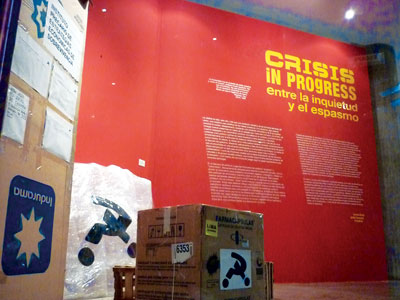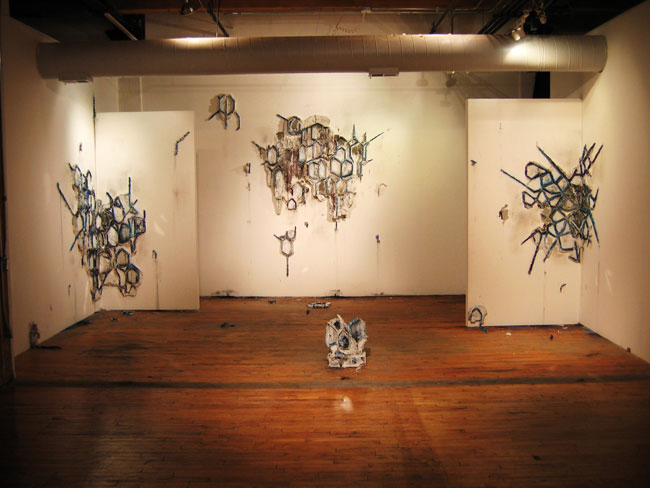SAIC grad student Dorota Biczel in Lima, Peru
By Ania Szremski

Some of the most intriguing artists that you’ve never heard of are the subject of SAIC grad student Dorota Biczel’s thesis research. A double master’s candidate in Modern Art History, Theory and Criticism and Arts Administration and Policy, Biczel has discarded the usual suspects for an art history thesis in favor of uncharted territory: the contemporary Peruvian art scene. Writing about artists Eduardo Villanes, Luz María Bedoya and Juan Salas Carreño, Biczel is breaking important new ground as she questions and complicates accepted art historical narratives concerning Latin America.
Eduardo Villanes’ “Gloria Evaporada” is one project Biczel intends to feature in her writing. In 1995, the artist plastered the cement wall surmounting the Via Expresa (the major highway that slices through Lima) with cartons of Gloria-brand evaporated milk, arranged to spell out “EVAPORADOS.” This was just one of several interventions the artist conducted between 1994 and 1995 to protest the massacre of a university professor and nine students by a government-sponsored death squad, one of the crimes which resulted in Peruvian ex-president Fujimori’s conviction for human rights crimes in 2009. Gloria Evaporada reveals the high stakes at play in contemporary Peru, where artists boldly tackle pressing political, social and ontological issues in a political environment that has often been less than hospitable to critique.
Villanes is largely unknown to the outside world. Peruvian contemporary art has been mostly left out of the global art discourse, due in part to rather anemic art criticism and arts publication infrastructure at home, as well as the prejudices of certain writers and curators who are bent on establishing hierarchies within Latin American studies. For instance, in the catalogue essay for her landmark survey exhibition of avant-garde Latin American art, “Inverted Utopias,” superstar curator Mari Carmen Ramirez dismisses avant-garde art movements in Peru as “unarticulated formal echoes of movements such as Impressionism [… that] did not yield more than academic stalemates of the original impulse.”
Mari Carmen’s snub is the norm in emerging art historical narratives concerning Latin America. This new and rapidly evolving body of scholarship is replete with veritable panegyrics to the Mexican Muralists, pensive meditations on Argentine conceptual art of the 60s and loving tomes dedicated to the young Cuban artists of the 80s; but when it comes to nations like Peru, Chile or Ecuador, there is a virtual wasteland where criticism and scholarship should be. Peru, it would appear, is the home of Macchu Picchu and Paddington Bear– not a center for robust contemporary art.
Biczel’s research and writing intends to change all that. “Researching countries that supposedly don’t have contemporary art can perhaps upset a new Latin canon that people like [Ramirez] seem to be set on building,” she said. “I think for me, the key is to assure that we can tell a complicated story, not just a simple one… Perhaps because I was first trained as an artist, I am interested in making sure that we can tell many stories, not just a few.” Biczel, who is Polish, juggles her SAIC course load with teaching classes at the University of Milwaukee, her job at the Walker’s Point Center for the Arts, freelance writing jobs and her own artistic practice, amongst other pursuits.
She says that her interest in Latin America developed while she was growing up in Poland, where writers of the “boom” generation like Borges and Cortázar enjoyed immense popularity; this initial interest developed after moving to the U.S. in 2002: “I lived in a heavily Hispanic neighborhood full of local activists… I became very interested in the history of Latin America, and especially U.S. policy in the region,” Biczel explained.
In the winter of 2009, she accompanied SAIC’s Department of Arts Administration and Policy on a study trip to Mexico and Peru, visited galleries and museums, and met with artists, theorists and curators like Cuauhtémoc Medina. During this trip, Biczel was struck by what she felt were strong political and cultural similarities between Latin American countries and Poland as a result of recent neoliberal economic policies.
“I think that when these countries opened up politically and economically to the outside, the arts were (and have been) under a lot of pressure, and went through a period of quite rapid transformations—not always for the better. A ton of interesting questions arose in those circumstances,” she said. Biczel returned to Lima in the summer of 2009 to work with local curators and critics Emilio Tarazona and Miguel Lopez, where she was able to explore those interests in-depth by co-curating the exhibition “Crisis in Progress: entre la inquietud y el espasmo” at the Galería ICPNA San Miguel with Tarazona.
The curators asked artists to explore the cultural and artistic ramifications of Peru’s rapidly changing economic policies and the profound structural problems they create, the nation’s apparent economic health in the midst of the global financial crisis notwithstanding. Organized in less than two months, the exhibition featured installation-based work from a dozen Peruvian artists, ranging from young emerging artists like Christians Luna, Janine Soenens and Ishmael Randall to more established artists like Eduardo Villanes, Alfredo Márquez and Luz Maria. “Co-curating this show was a huge privilege,” said Biczel, “because many artists chose to do new projects for the show and, as a result, I got to work with them very closely in the process and got to know them quite well… Above all, it was an incredibly humbling experience—suddenly, when you’re thrown into a situation where you don’t really speak the language, you get reminded how much your abilities depend on communication skills, and how little all theoretical knowledge and even clear ideas matter!”
Although she has since become more proficient in Spanish, Biczel feels that the language barrier continues to be her largest obstacle in her thesis research, stating, “I don’t think long-term and in-depth research can be done without language proficiency” (a declaration that throws SAIC’s lack of a language requirement for M.A. students into sharp relief). Aside from the language issue, Biczel also expresses frustration at some of the bureaucratic obstacles that she’s faced in attempting to access documents in Peruvian libraries, as well as the fact that she’s researching a topic that has been virtually untouched by other writers.
“A huge challenge lies in the fact that I am writing about the stuff that has not been written about– at least not in a scholarly manner– and that it as interesting as it is intimidating. In that respect, ‘applying theory’ to it seems particularly daunting. I feel it’s a huge responsibility,” she said.








this is too long.
i know